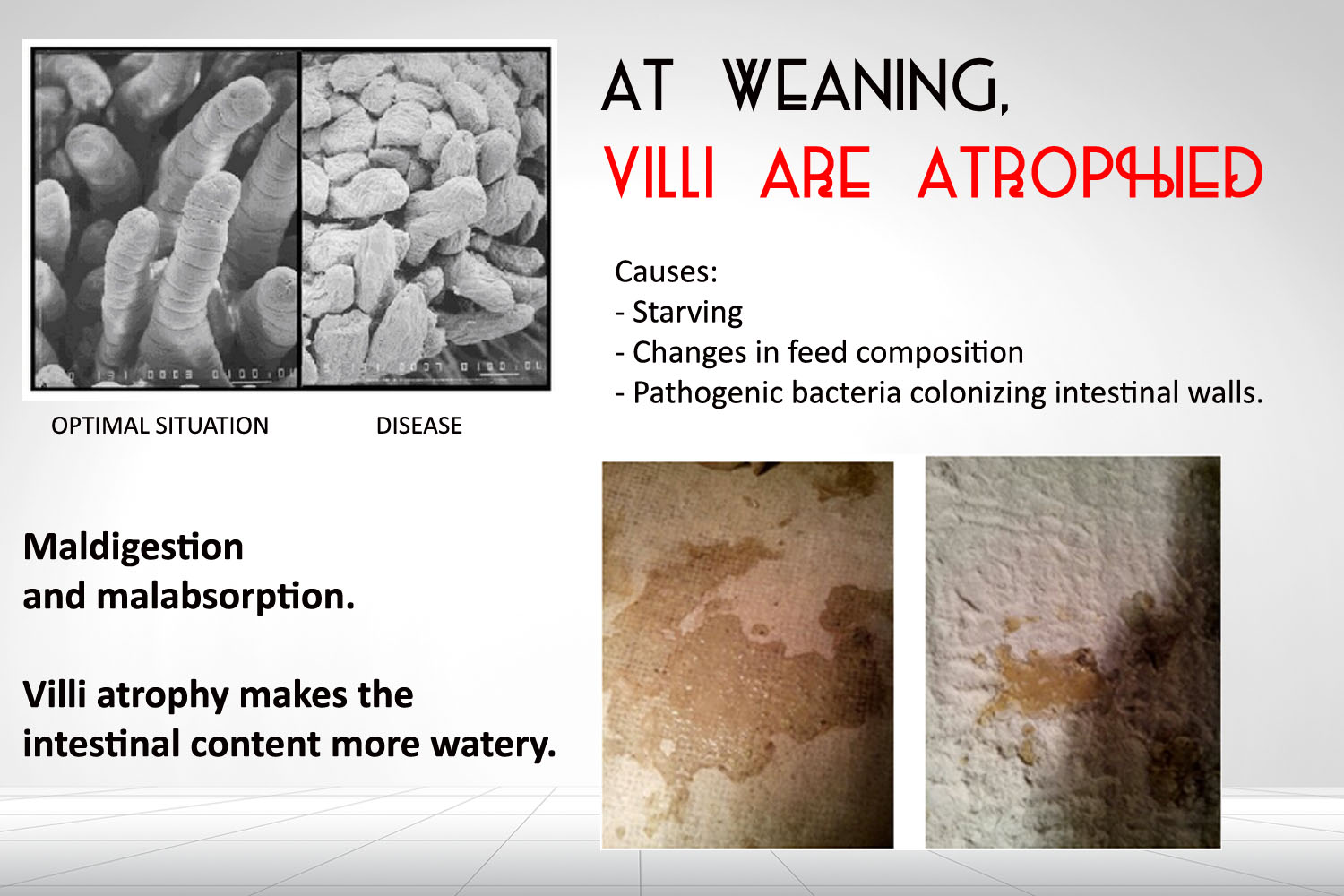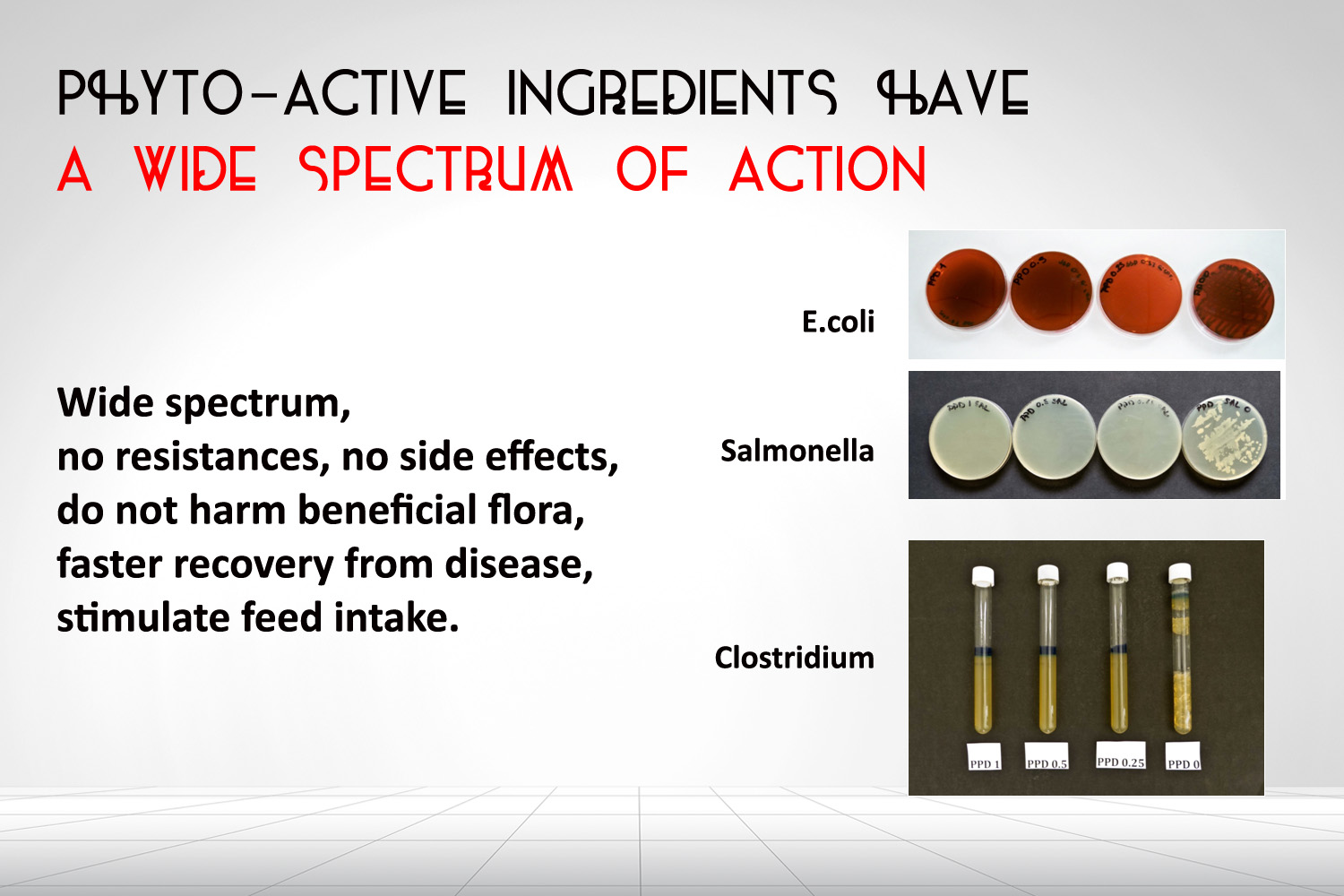02 Feb Post weaning gap: health and economic consequences

The following slides are an excerpt of the seminar we gave during VIV China 2014.
Weaning is a traumatic time for the suckling piglet, as the animal faces sudden big social, environmental and nutritional stressors. During the first 3 to 4 days post weaning it loses weight and may not consume enough feed or water to meet its needs. As a consequence, immediately after weaning, there is a significant slowing down of the weight gain rate, that drops below genetic potential. This is called post-weaning gap or post-weaning check or post-weaning growth drop.
Lorem ipsum dolor sit amet, consectetur adipiscing elit. Ut elit tellus, luctus nec ullamcorper mattis, pulvinar dapibus leo.

It has been demonstrated that post-weaning performance has a strong influence on the time to reach market weight. As a consequence, pig producers set up a number of strategies to make the post-weaning gap as short as possible. The average duration is 7 to 10 days, while best farms around the globe manage to shorten it to 1 to 2 days.

Shortening the post-weaning gap involves many productive and economic benefits:
- 10% better daily weight gain during the whole nursery period.
- Saving up to 7% in feed from weaning to slaughter.
- Reduction of the days needed to reach market weight, averaging 8 to 14 days less.
MEASURE AVERAGE DAILY WEIGHT GAIN
Average daily weight gain during the first 14 days post-weaning is the most useful indicator of the performance during the post-weaning gap. Improvements on the nutrition, health and management during post-weaning are translated into better average daily weight gain during these two weeks.
This parameter is also positively correlated with:
- Weight at the end of the nursery period.
- Body weight at slaughter
- Total days needed to reach market weight.
Therefore, once average daily weight gain during the first 14 days improves consistently in our farm, we should see statistically better productive results during the finisher period.
It should be noted that measuring average daily weight gain over short periods of time is less accurate because of variation in the filling of the stomach and the level of hydration of the animals.

WHAT HAPPENS AT WEANING?
In nature, weaning process takes 16 to 20 weeks. The piglet has time to adapt.
On the farm, changes are fast. The hardest change to the piglet is the feeding system. The animal does not know how to feed itself:
- 95% of the animals put the head in the feeder during the first day.
- 80% of the piglets eat a small amount during the first and second day. It may take some days to reach normal feed intake.
- 5-10% of piglets will refuse completely to eat during several days.
This behavior is due to the natural wild instinct of the piglet. Starter feed is a novel food source for the animal; it will eat a very small amount and then starve for some time, instinctively testing the feed for any toxic effect. After the experience of “safe food”, the hungry piglet will eat a considerable amount, overfeeding, to reach a regular pattern afterwards.
If they eat creep feed before weaning, the percentage of animals that eat feed during the first two days is much higher.

WHAT HAPPENS WHEN PIGLETS OVERFEED?
In the slide above we discussed that piglets often overfeed after a period of starvation. Stomach of the weaned piglet is not adapted to solid feed, it is small and not able to expand, so when the animal overeats, feed passes without being digested into the duodenum.
Undigested feed in the duodenum is a substrate for pathogenic bacteria, and the growth of pathogenic bacteria may lead to digestive infections.

IN ADDITION, DIGESTIVE SYSTEM IS NOT READY FOR SOLID FEED
Gut health in weaned piglets depends on several factors:
1. Factors related to digestive anatomy:
1.1. Secretion of digestive enzymes
Enzymes are necessary for the proper digestion of feed. At weaning, the piglet does not produce enough enzymes to digest completely proteins and fats. Undigested feed in intestine can be a substrate for pathogenic bacteria.
Some compounds such as those contained in cinnamon are able to stimulate the production of digestive enzymes secreted by pancreas and intestinal mucosa, leading to a better feed use and a significant increase in growth.
1.2. Secretion of hydrochloric acid
In stomach, hydrochloric acid has two main functions: the activation of pepsin, the enzyme responsible for protein digestion, and the maintenance of the stomach pH between 2.5-4. Acid pH in stomach is a powerful barrier against pathogenic microorganisms.
At weaning, secretion of hydrochloric acid is low and the pH of the stomach is above 5, with two main consequences: poor protein digestion, which means that undigested proteins will be present in the gut, and disappearance of the acid barrier, which allows more pathogenic microorganisms to arrive to intestine.
1.3. Structure of intestinal epithelium
Structure of intestinal epithelium is divided in villi and crypts. Many biochemical pathways that are responsible of feed digestion and absorption are located on the surface of these villi and crypts. The higher the villi and deeper the crypts, the more surface is in contact with feed and, as a consequence, feed digestion improves. If the animal starves, like immediately after weaning, the epithelium becomes atrophied, assuming a “flat” structure, leading to poor feed absorption and making the feces and the intestinal content more watery.
Some phytoactive ingredients have been proven to enhance villi development. This is the case of phenylpropanoids, found in cinnamon and oligosaccharides present in chicory.
1.2. Factors related to gut flora
In post-weaning piglets, it is easier for pathogenic microorganisms to grow without control because:
- Gut flora is not stable due to the changes in feed. It will not stabilize until 20 days post-weaning.
- Presence of undigested proteins in intestine.
- Not enough bydrochloric acid secretion in stomach, which means that more pathogenic microorganisms arrive to intestine.
Some plants rich in oligosaccharides, such as chicory, are able to stimulate the growth of favorable bacteria without promoting the growth of pathogenic species. Other plants, such as cinnamon or marjoram, are able to exert a microbiocide effect, keeping the pathogenic microorganisms under control. This phyto-active ingredients have a wide spectrum of action, do not create resistance and do not have secondary effects such as slow down in growth.









THE IMMUNE SYSTEM IS IMMATURE
The immune system of the piglet is completely immature at birth and depends highly on the supply of specific and non-specific immune factors from the sow, that are acquired through colostrums and milk. Without these immune factors supplied by the sow, the piglet cannot develop nor survive. Shortly after birth, the supply of immune factors from sow to piglet begins to decline.
When the piglet is 2 weeks old, it is already capable of some active immune responses but its immune system does not reach maturity until 8 weeks of age.
If the piglets are weaned when they are between 21 and 28 days old, the levels of immune factors provided by the sow are very low the piglet’s active immunity is not fully developed. The phyto-active ingredients contained in cinnamon and the administration of vitamin E stimulate the active immunity and make the animal more resistant to diseases.


WHAT TO DO TO OVERCOME THE POST-WEANING GAP?

1. Pay attention to starter feed
- Use a specialized starter feed, also called link feed, for 7 to 10 days post-weaning.
- Highly digestive ingredients (similar to creep feed). Inclusion of cooked ingredients, enzymes, organic trace elements, protected vitamins. Avoid anti nutritional factors.
- Rich in amino acids but low in total protein (around 17%).
- Reduce or eliminate the presence of antibiotic growth promoters in link feed that can affect beneficial flora. Use phyto-active ingredients.
- Practice restricted feeding for 12-36 hours post weaning.
Effects of adding phyto-active ingredients in feed
Summary of several trials:
- Weight gain during post weaning gap is improved by 13-20%.
- Mortality is reduced by half.
- Feed intake increases by 13%.
- FCR improves by more than 3%.
- Gut welfare improves and feces appearance is normal.
- The need of antibiotics to treat diarrhea of bacterial origin is reduced.
2. Keep hygiene in mind
- Biosafety, all in all out.
- Pay special attention to the cleaning of the feeders.
3. Water is extremely important
Newly weaned pig has a very low water intake, around 1 litre of water in the first 3 days after weaning. Such low water consumption reduces the ability to digest feed and increase the occurrence of diarrhea. Moreover, if there is not enough water intake, toxins accumulate in the body and growth is reduced.
Therefore, it is necessary to stimulate water intake in the period immediately after weaning. Increasing the water flow in the drinker is a very effective way to achieve this target: increasing the water flow from 175 ml/min to 450 ml/min, the daily water consumption doubles and feed intake and daily weight gain also improve.
Phyto-active ingredients to improve digestive health and boost growth can be added to drinking water, especially when the farmer has no control of feed composition.
Summary of several trials with phyto-active added through drinking water:
- Reduces the ocurrence of diarrhea by 17%. Avoids dehydration.
- Decreases mortality by 3.5%.
- Can replace totally antibiotic growth promoters.
- Improves weight gain by 7-40%, depending on the length of treatment, feed intake by 7.5% and FCR by 6.1%.
4. Keep a comfortable environment
- Allow extra space in feeders or put an extra feeder during the first 10 days.
- Be sure the pens stay clean, confortable for the piglets and warm (27 to 29 ºC, depending on the weight of the pig). Avoid chilling and air spills.
Products of choice
PigletPlus© is intended to maintain and improve digestive health. It is formulated with synergistic ingredients:
- Bactericidal and fungicidal plant extracts, combined with organic acids for better effectiveness, that reduce the number of pathogenic microbes in the digestive system.
- Plant extracts with prebiotic effect, that promote the growth of beneficial bacteria in the gut.
- Immunostimulant and antioxidant plant extracts.
- Silicates with mycotoxin binding function.
It is especially useful in cases of bacterial diarrhea during the suckling and post weaning period, and to promote growth in all ages.
SupraPlus© is intended to maintain and improve digestive health and to improve hydration in poultry, ruminants and swine of all ages. It is given through drinking water and is formulated with synergistic ingredients:
- Bactericidal and fungicidal plant extracts, combined with organic acids for better effectiveness, that reduce the number of pathogenic microbes in the digestive system.
- Plant extracts with prebiotic effect, that promote the growth of beneficial bacteria in the digestive system.
- Electrolytes to maintain hydration
- Sugars that are quickly absorbed and can be easily used as a energy source
- Vitamin E
It is especially useful during the first week of life, to promote a healthy development of the digestive system and improve hydration; in case of digestive diseases, to improve gut health and restore the levels of electrolytes; in episodes of heat stress, to prevent digestive problems, restore the levels of electrolytes and fight with the body oxidation caused by free radicals.

Certain health statements may not be applicable in your region.

